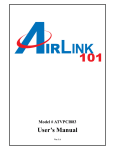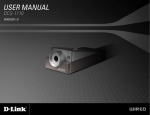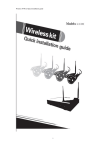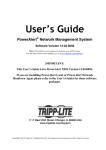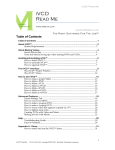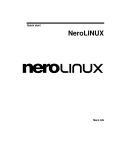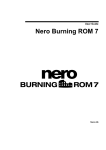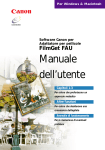Download User`s Manual
Transcript
Model # ATVUSB01 User’s Manual Ver. 1A Table of Contents CHAPTER 1 INSTALLING HARDWARE ...................................................................................................... 2 1.1 Package Contents ................................................................................................................................. 2 1.2 Minimum System Requirements.......................................................................................................... 2 1.3 Upgrading USB 2.0 Host Controller Driver ........................................................................................ 2 1.4 Hardware Installation ........................................................................................................................... 3 CHAPTER 2 INSTALLING VIDEO CAPTURE ADAPTER DRIVER .......................................................... 3 CHAPTER 3 INTSTALLING PVR-PLUS........................................................................................................ 6 CHAPTER 4 USING PVR-PLUS ..................................................................................................................... 8 CHAPTER 5 USING TVR ................................................................................................................................ 9 5.1 Main Panel Functions........................................................................................................................... 9 5.2 Schedule Function.............................................................................................................................. 12 5.3 Setup Utility ....................................................................................................................................... 14 5.4 Snapshot ............................................................................................................................................. 16 5.5 Sleeping Timer ................................................................................................................................... 16 CHAPTER 6 USING MPEG ENCODER ....................................................................................................... 17 6.1 Interface Explanation ......................................................................................................................... 17 6.2 Streaming Video Translation.............................................................................................................. 17 6.3 Translation Option Dialog.................................................................................................................. 19 CHAPTER 7 USING VIDEO EDITOR .......................................................................................................... 22 7.1 Menu Area.......................................................................................................................................... 23 7.2 Display Area....................................................................................................................................... 24 7.3 Original and Staging Clips ................................................................................................................. 24 7.4 Frame Edit Mode ............................................................................................................................... 25 CHAPTER 8 USING DVD MAKER .............................................................................................................. 27 8.1 Adding Files ....................................................................................................................................... 27 8.2 Burning............................................................................................................................................... 28 8.3 Video Specifications........................................................................................................................... 29 CHAPTER 9 FAQ............................................................................................................................................ 31 Appendix A ...................................................................................................................................................... 33 Product Specifications.............................................................................................................................. 33 Appendix B ...................................................................................................................................................... 34 Technical Support..................................................................................................................................... 34 1 CHAPTER 1 INSTALLING HARDWARE 1.1 Package Contents Unpack your Airlink101 video capture adapter and make sure that all the items are intact. The following items should be included in your package: Airlink101 video capture adapter Quick Installation Guide Installation CD-ROM 1.2 Minimum System Requirements Intel Pentium 4 1.6GHz or above CPU 256 MB RAM 200 MB available hard disk space One available USB port (USB 2.0 recommended) Microsoft Windows 2000/XP VGA with DirectDraw driver supporting Overlay Surface (DirectX 8.1 supported) AC 97 compatible sound card Speakers for audio output CD-ROM drive 1.3 Upgrading USB 2.0 Host Controller Driver Before you plug the Airlink101 video capture adapter into your computer’s USB 2.0 port, please check your USB 2.0 device driver first. If your USB 2.0 host controller driver is not the latest version or provided by Microsoft, we strongly recommend you use our “USB 2.0 Updater” utility from the autorun page on the CD. It will help you to upgrade your USB 2.0 driver to the latest version released by Microsoft in order to avoid some compatibility issues. Note: DO NOT connect the video capture adapter to your computer when you are using the USB update utility. 2 1.4 Hardware Installation After you have updated the USB 2.0 host controller driver to the latest version, you can install the Airlink101 video capture adapter. Please refer to the diagram below as you follow the installation procedures. Note: Be sure to follow the steps carefully and plug in the USB 2.0 connector last. 1. Connect the Composite In (or S-Video In) and Audio In connectors to the output cables of your video/audio source. 2. Connect the Audio Out cable of the video capture adapter to the Line In port of your sound card. 3. Connect your speakers to the Line Out port of your sound card. 4. Connect the USB 2.0 connector to the USB 2.0 port of your computer. CHAPTER 2 INSTALLING VIDEO CAPTURE ADAPTER DRIVER Before installing the driver, it is highly recommended that all background applications such as antivirus software and system monitoring programs be disabled first. 1. When you plug in the video capture adapter’s USB 2.0 connector to the USB 2.0 port of your computer, the Found New Hardware Wizard will appear. Make sure the Installation CD is still in your CD-ROM drive and click Next. 3 2. Select Search for a suitable driver for my device and click Next. (For Windows XP, select Install software automatically and click Next). 3. Select Specify a location, deselect every other option, and click Next. 4. Click Browse and browse to the Driver folder in your CD-ROM drive. Example: 4 D:\Driver (where D is the letter of your CD-ROM drive). 5. Click Next to install the driver. 6. Click Yes if the Microsoft Digital Signature message appears. (For Windows XP, click Continue Anyway). 7. Click Finish to complete the driver installation. 5 CHAPTER 3 INTSTALLING PVR-PLUS PVR-PLUS is a set of utilities that allow you to record videos, edit video clips, burn DVDs, and more. Before installation, it is highly recommended that all background applications such as antivirus software and system monitoring programs be disabled first. 1. Insert the provided Installation CD-ROM and wait for the setup menu to appear. 2. Select PVR PLUS at the setup menu. If the setup menu does not appear automatically, go to Start, Run, and type D:\autorun.exe (where D is the letter of your CD-ROM drive) and click OK. 3. Click Next to begin installation. 6 4. Click Next to accept the default Destination Location or click Browse to choose a new location. 5. Click Next to accept the default Program Folder. 6. Click Finish to complete the installation. 7 CHAPTER 4 USING PVR-PLUS Double-click the PVR Plus icon on your desktop to run PVR-PLUS. After you started PVR-PLUS, you can select the application you want to use. Click on each icon to start the application. • TVR: TVR turns your PC into a full-featured video recorder. (For detailed instructions, please refer to chapter 5). • MPEG Encoder: MPEG Encoder converts DV/AVI files into MPEG/DVD format. (For detailed instructions, please refer to chapter 6). • Video Editor: Video Editor allows you to edit MPEG/DVD videos. (For detailed instructions, please refer to chapter 7). • DVD Maker: DVD Maker lets you create VCD, SVCD, and DVD that can be played on a PC or DVD player. (For detailed instructions, please refer to chapter 8). Note: You can also view and edit pictures using PVR-Plus. For detailed information about how to view/edit the pictures, click the ? button on the PVR-Plus console. 8 CHAPTER 5 USING TVR TVR allows you to watch and record videos on your computer as well as to playback the recordings. 5.1 Main Panel Functions The display window shows the current or recorded videos. You can drag it anywhere on the screen or adjust its size by double-clicking it to switch to full-screen and double-clicking the screen again to return to its original size. The TVR has five major parts. 5.1.1 Information Window The Information Window displays the current status of the TVR, including video status, (Live, REC, Playback, Time-Shifting), recording time, recording file size, and the current time. 5.1.2 Basic Tools The Basic Tools have five buttons. You can click on each button for more specific functions. For detailed instructions on each button, please refer to the following sub-sections. Input Source Switch: Changes the video input source : Scheduling: schedules recording date/time : Setup: opens the Setup Utility : Snapshot: takes a snapshot of the current image in the display window : Sleeping timer: configures the sleeping timer Note: The two other buttons are reserved for models with TV Tuner function. 9 5.1.3 Input Source Switch There are two video input sources to choose from: Composite and S-Video. You can change the video input source by clicking on the Input Source Switch button, or choose Switch Video Source from the popup menu of the display window. When the video source is changed successfully, the Input Source Switch will display the corresponding source. 5.1.4 Volume Adjust Adjusting Volume: : Increase volume : Decrease volume : Mute or restore sound 5.1.5 Record, Playback, Time-Shifting 1. Record At Live mode, you can start recording the current video by clicking on the capture button . Once you are capturing, click the stop button to stop recording. You can review your recorded files in the Play list after recording. 2. Playback You can playback the recorded files by clicking on the play button . A playback dialog box will appear, showing all the captured files and recently played files. Select the files you want to playback and click Add to add them to the Play list. You can add more than one file at a time, and you can also import files from other locations. Once you have added all the files to the Play list, click OK to begin playback. 10 While playing, you can use following functions: • Play button • Pause button • Stop button : Stop current playback and go to Live mode • Backward button : Go backward • Forward button : If the video is paused, resume playback : If the video is playing, pause it : Go forward 3. Time-Shifting The Time Shifting function allows you to record and playback videos at the same time. At Live mode, you can perform time-shifting by clicking on the time-shifting button . Once you are in time-shifting mode, you need to wait at least 10 seconds before you can playback the recorded video by clicking on the play button time-shifting, click the stop button . If you want to stop . During time-shifting, you can switch between the current video and the recorded video by selecting Real Screen from the popup menu of the display window. 11 5.2 Schedule Function Click on the Schedule button to configure the Scheduled Recording Agent. Click OK when you are done configuring. Capture Capture Source: Select the video input source (Composite or S-Video). Capture format (profile): Select the video format you want to use. Note: If you want to burn your captured videos to DVD, be sure to set the capture format to DVD (NTSC) and not MPEG 2. Capture size: Set the video capture size. Bit rate (Kbps): Set the capture bit rate. Capture quality: Set the capture quality. Frame rate: Select the frame rate. Capture audio option: Select from “Capture audio”, “Capture audio only, No video”, or “No audio”. File name option: You can use the date/time as your capture file name or assign a name yourself. Time option Current time: Shows the current time. Starting time: Enter the date and time when you want to start recording. Duration: Enter the length that you want to record. Recording rule: Select the recording rule you want to use. The default is "Once only.” When you enter a record schedule, it will be added to the Open tab of the Scheduled Recording Agent. Insert: Insert a new record schedule. Edit: Edit the record schedule. Delete: Delete a record schedule. Delete All: Delete all record schedules. Execute TVR: Starts the TVR program. 12 Today To-do List: displays all of today’s record schedules. Click Refresh to update the list. Log: If your record schedule has failed, the error message will be recorded in the Log. You can check for any message in the Log. Click Clear to clear the log. Setup: Output folder: Assign a destination folder to store your scheduled recorded files. Auto-execute at start up: Allows the Scheduled Recording Agent to start at Windows start up. Default is enabled. 13 5.3 Setup Utility Click on the Setup button to enter the Setup Utility. 5.3.1 Capture Video capture device: Select your video capture device. Video input format: Select your video input format (UYVY, YUY2, RGB24). Capture format (profile): Select the video format you want to record as. Note: If you want to burn your captured videos to DVD, be sure to set the capture format to DVD (NTSC) and not MPEG 2. Capture Size: Set the video capture size. Bit Rate (Kbps): Set the capture bit rate. Capture quality: Set the video capture quality. Frame Rate: Set the capture frame rate. Capture location: Set the folder to store your captured videos. Capture filename: Set the capture file name format. Choose either to name the files with date/time or as a custom name defined by you. Enable time limit: Check this box to set a time limit for the video capture. Capture audio option: Select from “Capture audio”, “Capture audio only, No Video”, or “No audio”. Audio capture device: Select the audio capture device you want to use. Audio Source: Select the audio input source. (Recommended using Line In) Audio format: Select the audio format. For DVD, be sure to select 48000 Hertz. Recording level: Adjust the audio recording level. Click OK after you have configured all the settings. 14 5.3.2 Video Color: Move the slide bar to adjust the Brightness, Contrast, Hue, and Saturation of the video. Click Default to reset the settings to factory default. Video System: Select the video system for your Composite and S-Video inputs. Always on Top: The preview window will always be displayed on top of other windows. Enable high quality preview: Enables high quality preview mode. Don't use overlay as display surface: If your VGA card doesn't support Overlay mode, click on this option. Display Aspect Ration: Set the display aspect ratio to 4:3, 16:9, or free mode. 5.3.3 Other Multi language option: Select the language for the user interface. Enable PIP playback: Enables Picture-In-Picture function when you playback recorded videos. MPEG4 Codec: Select the appropriate MPEG4 codec to use while capturing videos in the MPEG4 format. (Choose from DivX, Microsoft MPEG4 Codec V1, V2, and V3). 15 5.4 Snapshot You can take a snapshot (still image capture) of the current image in the display window by clicking on the Snapshot button . When the image is taken, the snapshot window will appear. Click on the thumbnail to select the image. You can view, save, and delete the images. The save image option supports Bitmap and JPEG formats. You can select which format to save the image as when you click Save or Save All. Note: The snapshot button on the Airlink101 video capture adapter only works with programs that support the TWAIN function. For more information on how to use the adapter’s snapshot button, please refer to the FAQ in Chapter 9 of this manual. 5.5 Sleeping Timer Activate the sleeping timer by clicking on the Sleeping Timer button . Use the slide bar to adjust the time before auto shutdown, click OK to start, Cancel to exit. 16 CHAPTER 6 USING MPEG ENCODER The Mpeg Encoder lets you convert DV/AVI files into MPEG/DVD format. 6.1 Interface Explanation Below is the interface window for the Mpeg Encoder: The interface window is composed of four parts: Header Buttons (Upper Right) Batch Process Display Window (Upper Left) Add files, delete files, Edit options, Start and Stop encoding, Help files. Displays the file name, encoding status, screen size, audio format, and play time of the files to be encoded. Progress Display Window Displays formatting information about the file being (Lower Left) encoded. Preview Display Window Displays the video of the file being encoded. (Lower Right) 6.2 Streaming Video Translation MPEG Encoder converts multimedia files into MPEG/DVD format. For multimedia files to be encoded using the MPEG Encoder, they must be able to be played with Windows Media Player. File formats that can be converted are: AVI, DV-AVI, MPEG 1, MPEG 2, ASF, WMV, DivX, and DAT. 17 To add a multimedia file to be encoded, click on the + or Add button. This will open the Browse dialog box. Browse to the desired directory/file and click Open. Once the multimedia file is added to the Batch Process Display Window, the Option Selection Dialog Box appears. Select to encode the file as Mpeg 1 or Mpeg 2. For more information, refer to the Translation Option Dialog Section 6.3. The output file will be created in the same directory as the original file unless a different path is specified in the Output field. It will also maintain the original video file name and add a file extension matching the video format of the output type selected. The file name can also be changed manually. 18 6.3 Translation Option Dialog When a media file is added to the Batch Process Display Window, the Option Dialog Box will appear. Choose one of the formats and click on OK to continue. The MPEG-1 menu includes 7 profiles to choose from. Each profile displays the video bit rate of that format. The Following list explains each profile: Auto (match source) Calculates the most appropriate bit rate according to the screen size of the translating file Internet low band 256Kbps, QCIF(160*120), 23.976frame/sec, QCIF(Quarter CIF) Half Screen Intranet 384Kbps, QCIF(160*120), 23.976frame/sec, QCIF Full Screen Intranet 768Kbps, CIF(320*240), 23.976frame/sec, CIF(Common Intermediate Format) NTSC Create MPEG file suitable for NTSC of American color TV broadcasting PAL Create MPEG file suitable for PAL of European color TV broadcasting Video CD Create MPEG file suitable for creating video CD An inverse relationship exists between bit rate and compression. As the bit rate increases, the screen quality gets clearer, but the compression rate drops. If “Auto (match source)” is selected, the application will pick the optimized bit rate with respect to screen size. (Note: MPEG 1 & 2 formats have "Variable Bit Rates", that is, bit rates that can be adjusted). Selecting "Enable VBR" lets the application automatically compress the video while maintaining satisfactory screen quality within the maximum bit rate. Adjustments for video quality, resolution, format, aspect ratio, and Intra DC Precision can be manually set. 19 The MPEG-2 menu includes 7 profiles to choose from. Industry standard MPEG 2 DVD and SVCD profiles are included. Variable bit rate override can be manually selected. The Following list explains each profile: HP@H14 80Mbps, 1440*1152 (High Profile at High-1440) HP@ML 20Mbps, 720*576 MP@HL 80Mbps, 1920*1152 (Main Profile at Main Level) MP@H14 60Mbps, 1440*1152 MP@ML (DVD) Encode MPEG files suitable for creating DVD. Default 6Mbps MP@LL 4Mbps (Main Profile at Low Level) MF@ML (SVCD) Encode MPEG files suitable for creating SVCD. 2.5Mbps MPEG 1 & 2 profiles create audio files that are MPEG 1, Layer 2 in specification with bit rate choices of 128 Kbit/sec and 224 Kbit/sec. Video only: When selected, the encoder will only encode the video and not the audio. 20 Once the output video format and options are specified and the OK button is clicked, the file will appear in the Batch Process Display Window. The Batch Process Display Window shows the status of the media file in the Status column. 1. Waiting: the media file is queued and ready for encoding. Click on the encoding button to begin encoding. 2. Exclusion: the media file will not be encoded. 3. Done: the media file is successfully encoded. To change a file's status between Waiting and Exclusion (and vice versa), double-click on the file name. The Waiting status will change to Exclusion and be reported as "Skip". Similarly, a file with a "Skip" status when double-clicked, will change to "Waiting." When a file is in the Exclusion (Skip) status, you cannot encode the file. Double-click the file name to change the status to Waiting. During Encoding, the Status column displays the percentage of progress. Once the encoding begins, the Encoding button changes to a Stop button. If the Stop button is clicked during encoding, the process will stop. To view the encoded output video file, highlight the video file and click on the Output Play button. 21 CHAPTER 7 USING VIDEO EDITOR The Video Editor lets you edit and merge your videos and save them as new video files. The Video Editor's interface contains the following areas: • • • • • • • Menu Area: add/delete files, minimize/maximize window, exit, and help files. Display Area: play original video clips (left screen), play edited video clips (right screen), display saving progress information. Video Clip Staging Area: Original Clips (top), Staging Clips (bottom). Frame Edit Area: mark frame range, sequence arrangement, and merge multiple frames into one video. Title Edit Area: add title, font style, size, color, movement (straight line, curve line) Audio Edit Area: add audio and create sound effect Special Effect Edit Area: use Color Effect, Filter Effect, Transition Effect, Transition In Effect, Transition Out Effect, Noise Reduction Filter 22 7.1 Menu Area Button Descriptions Click the +/Add button to open a file • Supports MPEG 1 & 2 files (Video and Audio), AVI (DV-AVI). • Select a file and click Open. Click the -/Delete button to delete the file icon in the Original Clips area. Note: If you check the Delete File check box, the actual file will be deleted. : Mpeg Properties Dialog Displays your input mpeg file properties 23 7.2 Display Area Original Video Display Window (Left screen) • Displays original video. (Double-click or drag-and-drop the original video into this display window). • Videos in Staging Clips cannot be displayed in this window. • In Title editing mode, Title can be edited in this window. • In Audio editing mode, it displays registered audio files. • In Special Effect mode, it displays all available filters. • Displays the progress information when final video is created. Edited Video Display Window (Right screen) • Displays videos in Staging Clips. (Double-click or drag-and-drop the edited video into this display window) • Original Clips can be displayed in this window. • Preview function displays edited video in this window. 7.3 Original and Staging Clips 24 Original Clips (Top) • This is the area where video clips that need to be edited are added and managed. • Video clips can be dragged and dropped into the Original Clips area. • The sequence of video clips added can also be rearranged easily by dragging and dropping. 1.1 How to add video clips • Use the button in the menu area to browse and select video clips to add to the Original Clips area. • Drag and Drop the video files into the Original Clips area. 1.2 How to view and manage video clips in the Original Clips area: • To view a video clip in the Original Clips area, either double-click on the video or drag-and-drop the video clip from the Original Clips area onto the Original Video Display window. • Clicking on the right mouse button will bring up a popup menu. This menu performs the following functions: copy, delete, and show property information. Staging Clips (Bottom) • • • • This is the area where video clips are added after frame ranges are specified. Video clips can be managed for further editing in this area. Editing, deleting, and sequence arranging are done here. File properties for each video clip can be obtained by right mouse clicking on the clip. • Edit the clips using the four application buttons on the left side of Video Editor: "Cut", "Title", "Audio" and "Effect". 7.4 Frame Edit Mode 1. Frame Range Selection for Editing 25 • • • • Specify frame range To add an entire video clip, drag the clip from the Original Clips area and drop it in the Staging Clips area. To add portions of a video clip, drag the clip from the Original Clips area and drop it in the Original Video display window. Then using the Mark-in/Mark-out button, cut the portion of the video clip to be edited and then click on the cut button transfer the clip to the Staging Clips area. Repeat the above steps to add multiple video frames. to 2. Editing and Saving Video Clips In the staging clip area, you can: • • • • • • Rearrange the sequence of videos. Repeat the same scene by putting the same video frames multiple times. Delete sections of video. Review the edited video before saving using the preview function. Repeat the above steps. Save the final video when editing is completed. Note: For detailed information about editing the videos, click on the ? button in the menu area for additional help files. 26 CHAPTER 8 USING DVD MAKER The DVD Maker allows you to burn your videos into several video formats including DVD, VCD, SVCD, and DATA. Note: The videos need to comply with proper specifications in order for the DVD Maker to burn them successfully. Please refer to section 8.3 Video Specifications for more details. 8.1 Adding Files 1. : Select the format you want to create: DVD: For DVD. VCD: For Video CD. SVCD: For Super VCD. DATA: For multimedia data CD. 2. Click the add button . Select the video files and click Open. Note: Added files can be deleted. Click the delete button to delete any unwanted file. 3. When all the files are added, click the next button 27 . 4. Click Next to accept the default background image for your DVD Title page, or click Background to choose an image. Click Background again after you have selected your background image and click Next. 8.2 Burning If you wish to go back and modify your selections, click the back button . 1. Select the DVD/CD burner to use. 2. : Click the Option button to edit the options. - Select your video system: NTSC, PAL, or Both - Support XVCD and XSVCD: Data rate is not checked in order to support XVCD and XSVCD. - Perform writing test before recording: Check to ensure that the DVD/CD burner is functioning properly before actual burning. - Use Windows temporary directory: (Default) Uses Windows temporary directory as DVD Maker's temporary directory. 28 - Path: You can specify DVD Maker's temporary directory. 3. After selecting the DVD/CD burner and configuring the settings in the Option dialog box, click the next button to start burning the DVD or CD. 8.3 Video Specifications In order for the DVD Maker to successfully burn the videos, the video files must meet the video specifications of the desired video format. • Digital Versatile Disk (DVD) Specs: - NTSC: Size: MPEG2 720 X 480 pixels Video bit rate: Up to 9.8 Mbit/sec Frame rate: 29.97 frames/sec Audio: AC3, LPCM, MPEG-1 Layer2, 48 kHz - PAL Size: MPEG2 720 X 576 pixels Video bit rate: Up to 9.8 Mbit/sec Frame rate: 25.00 frames/sec Audio: AC3, LPCM, MPEG-1 Layer2, 48 kHz • Video CD (VCD) Specs: - MPEG1 352 X 240 NTSC Size: MPEG1 352 X 240 pixels Video bit rate: 1150 kbit/sec Frame rate: 29.97 frames/sec Audio: 224 kbit/sec MPEG-1 Layer2 29 - MPEG1 352 X 288 PAL Size: MPEG1 352 X 288 pixels Video bit rate: 1150 kbit/sec Frame rate: 25.00 frames/sec Audio: 224 kbit/sec MPEG-1 Layer2 • Super VCD (SVCD) Specs: - NTSC Size: MPEG2 480 X 480 pixels Video bit rate: max 2524 kbit/sec MPEG-2 (if the audio is in 224 kbit/sec), audio + video bit rate max bit rate is 2748 kbit/sec. Frame rate: 25.00 frames/sec Audio: from 32 - 384 kbit/sec MPEG-1 Layer2 - PAL Size: MPEG2 480 x 576 pixels Video bit rate: max 2524 kbit/sec MPEG-2 (if the audio is in 224 kbit/sec), audio + video bit rate max bit rate is 2748 kbit/sec. Frame rate: 25.00 frames/sec Audio: from 32 - 384 kbit/sec MPEG-1 Layer2 30 CHAPTER 9 FAQ Q1: How do I update my “USB 2.0 host controller driver”? A1: Please use our USB 2.0 update utility to update your USB 2.0 host controller driver. Put the provided Instllation CD into the CD-ROM drive, and the utility will automatically detect your USB 2.0 driver version. If your driver is the latest version, the following warning message will not appear. If your driver is not the latest version, you would see the following warning message. For step-by-step guide on how to update the driver, please refer to Chapter 1.3 of this manual. A2: You can install the latest Service Pack to avoid seeing the update message: For Windows 2000, please install Service Pack 4. The Microsoft USB 2.0 driver is included in Service Pack 4 for Windows 2000. The driver is designated as Microsoft USB Driver Version 5.1.2600.0. You can get them at Microsoft’s Windows Update web site. http://v4.windowsupdate.microsoft.com/catalog/en/default.asp For Windows XP, please install Service Pack 1. The Microsoft USB 2.0 driver is included in Service Pack 1 for Windows XP. The driver is designated as Microsoft USB Driver Version 5.1.2600.0. You can get them at Microsoft’s Windows Update web site. http://v4.windowsupdate.microsoft.com/catalog/en/default.asp 31 Q2: How do I use the snapshot button on the Airlink101 video capture adapter? The snapahot button on the Airlink101 video capture adapter only works with programs that support the TWAIN function. Some examples are Microsoft Word, ACDSee, and Photpshop. The example below uses ACDSee v3.1. 1. Open the ACDSee software. 2. Click on the “Acquire” button. The Acquire setup window will appear 3. Under the TWAIN source option, select “USB 2800 Video”. Configure your output settings and click OK. 4. You will see the Still Image Capture window. Press the snapshot button on the video capture adapter to capture the image. 32 Appendix A Product Specifications Key Features: • • • • • • • • • • Up to 30 fps @ 720 x 480 video resolution Proprietary compression algorithm for both still image and motion video capture Capture videos in Mpeg 1, Mpeg 2, and Mpeg 4 format Auto-adjust compression ration for USB 1.1 o USB 1.1 supports 30 fps @ 320 x 240 resolution o USB 2.0 supports 30 fps @ 720 x 480 resolution USB 2.0 Isochronous Video pipe up to 24 Mb/sec USB 2.0 Isochronous Audio CD quality pipe up to 1.4 Mb/sec Supports Composite and S-Video inputs Capture still images in BMP and JPEG formats Highly integrated VLSI provides a cost-effective solution for video capture application Picture-in-Picture playback Specifications: • Supports USB 1.1 and 2.0 Plug-and-Play USB interface • Supports MPEG 1, 2, and 4 o NTSC up to 30 fps @ 720 x 480 resolution o PAL up to 25 fps @ 720 x 576 resolution • Video inputs: Composite Video and S-Video • Audio inputs: Left and Right channels • Audio output: Stereo audio output 33 Appendix B Technical Support E-mail: [email protected] Toll Free: 1-888-746-3238 Web Site: www.airlink101.com 34




































